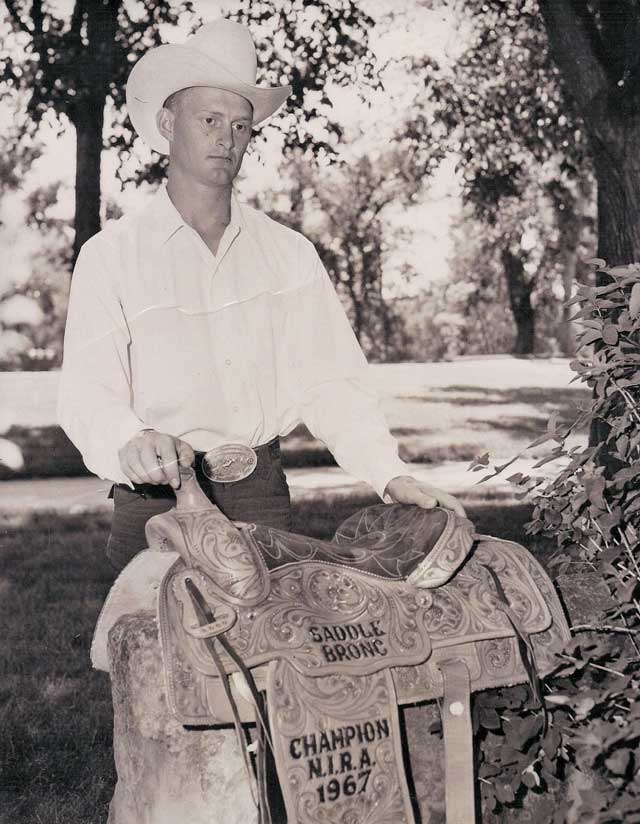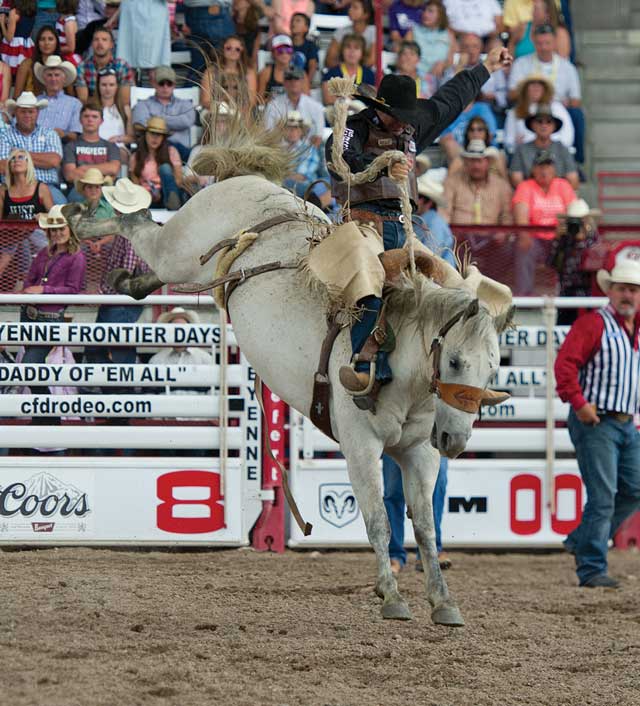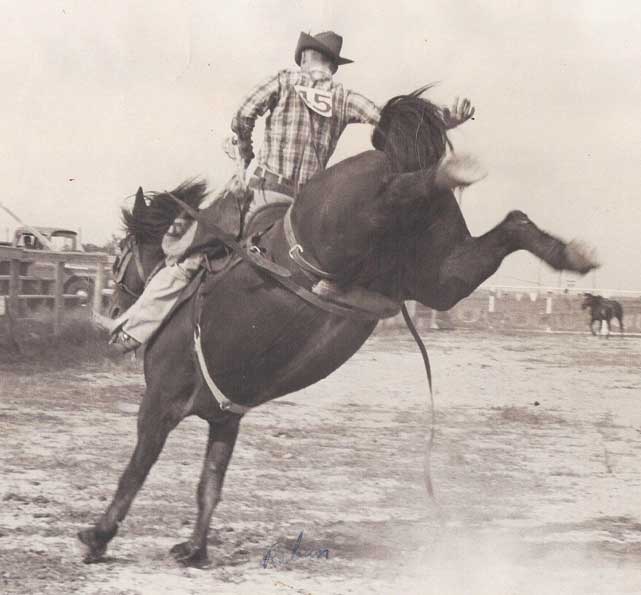Dave Dahl can spot one of his saddles from a mile away. When the bronc saddle maker from Ft. Pierre, S.D. watches pro rodeo, he can see the saddles he’s made aboard the bucking horses in the saddle bronc riding.
And the list of cowboys using his saddles sounds like a “who’s who” of great saddle bronc riders: 2016 world champion Zeke Thurston, world champions Taos Muncy (2007 and 2011), Jeff Willert (2005), Glen O’Neill (2002), and Cody DeMoss, Jake Watson, CoBurn Bradshaw, Chuck Schmidt, Clay Elliott, Wade Sundell, Cort Scheer, Kyle Whitaker, Jeremy Meeks, Shade Etbauer, and more.
The 72 year old cowboy grew up on a farm near Keene, North Dakota, next to an Indian reservation, “where there were cowboys,” he remembers. He and his friends used to go to the reservation, round up horses, and ride them. “We didn’t know what the horses were like,” he said. “We just ran in a bunch of them. There were a few chutes, and we practiced. We had some wild times,” he chuckled. After graduating from high school in 1962, he went to the oil fields. But he knew he didn’t want to spend his life there, so he went to college in Madison, S.D.
Eastern South Dakota wasn’t for him, either. “It was too much ‘east river’ for me, and I liked the Black Hills.” He made a phone call to Black Hills State University in Spearfish, S.D., and a few months later, he was there, on the rodeo team riding saddle broncs. As a member of the men’s team, he won the 1967 National Inter-Collegiate Rodeo Association year-end saddle bronc riding title, qualifying for the College National Finals Rodeo four times and competing there twice.
After graduating with a teaching degree, he taught a year at Pine Ridge, S.D., a year at a country school near Fruitdale, S.D., and a year in Eagle Butte.
He was doing construction work in Ft. Pierre, when he and a rodeo buddy, Dick Jones, ran across each other. Jones was making saddles, and Dave wanted to make his brother one. Dick helped him, and that was the beginning of Dave’s saddle career. Dick had made some saddles, and he gave instruction to Dave. “He knew a little bit, and I didn’t know much,” Dave recalled. “He showed me, and one thing led to another.” The two began a partnership in a saddle shop in Ft. Pierre.
Dave, being a saddle bronc rider (he won the 1968 SDRA title and had a Rodeo Cowboys Association card), made bronc saddles. His saddles are different from other brands, and the cowboys who ride them, love them.
Dahl’s bronc saddles differ from other makers in several ways, including the swells and the cantle. The swells are set higher so that a cowboy’s feet can set high in the neck of the horse, but not too high. The seat is a bit deeper, and the cantle is higher. Where a cowboy’s hips are is crucial. Chuck Schmidt, a saddle bronc rider from Keldron, S.D. and a three-time Wrangler NFR qualifer, has ridden a Dahl saddle since he started pro rodeo. “As in any sport, your hips are your power, and bronc riding is the same,” he said.
“You almost have to sit back on your butt a little, not just sitting there straight up, like you’re going to rope. You want to set back, (to reduce) the force the horse will use to throw you forward. You counteract it it by sitting back.”
The gullet on the saddle is also set narrower, so the saddle can sit higher up on the withers. “Beings it’s not a roping saddle, you can set your swells higher by bringing the bars in, thus allowing the cowboy to spur better,” Schmidt said. “If the swells are set too low and too wide, it’s harder to reach your feet up into the neck. When you narrow the swells and set them up higher, your legs are closer to the horse’s neck, creating better spur contact when you ride.”




Dahl’s saddles make riding broncs easier, Schmidt said. “Dave designed a saddle to take away half of your work as a bronc rider, the way it sets a horse and the way it sets the cowboy. It sets it up a little more natural, the way everything moves. There are minimal things to get in your way.”
For some cowboys, switching to a Dahl saddle made them a better rider. It happened for Zeke Thurston, who won last year’s world title. The Big Valley, Alberta cowboy wasn’t riding well last spring. He decided to give Dahl a phone call. Dahl had a new saddle to him within five days, and Thurston took it to the Guymon, Okla. rodeo. “It took me a few rodeos to get it dialed in,” he said. “Once I broke it in, my spring skyrocketed. There were probably four weekends in a row where I won $12,000 or more.” He credits the saddle with giving him better spur outs and better upper body control.
Jake Watson, Hudson’s Hope, BC., finished the 2016 season in fifth place in the world, and also uses a Dahl saddle. “The way the swells and cantle are shaped, the structure of them, they have a lot of forgiveness in them,” he said. “If you lift on your reins, you can turn loose and the saddle will do its job and keep ahold of you.” The different shaping of the swells and cantle make a difference. “Say you’re getting bucked off, and you’re still trying to spur, more often than not, you’ll end up back in the saddle and regain your position in the seat, which is definitely what you want.”
Watson has used a Dahl saddle since June of last year, and it has made a difference for him. “It changed my career, honestly,’ from the very first horse I got on,” he said. “I was having hell. I had won $2,000 that season (up till June), and from the end of June till September I ended up winning $20,000. Itw as a big turning point in my bronc riding.”
Dahl works out of his shop, the Diamond D Western Wear and Saddle Shop, on the main street of Ft. Pierre. He sells clothing, boots, hats, tack, and ropes, and does his leather work in the back of the shop.
And when most people are retired and drinking coffee all day, Dahl is working. He’s turning out about a saddle a week, working on number 1657 in mid-January. He puts in long days, clocking in about 8:30 am and working till 6:30 or 7 pm, six days a week, “depending on how bad I want to finish something.” The good work ethic comes from the motivation to succeed. “I guess I made up my mind that I wanted to be the best at what I’m doing. When you see the good results of the cowboys, it’s a big incentive.” And making saddles supplements the store’s income. “I’m fortunate that I can make a good living in my workshop when things are quiet in the store. That makes it nice.”
As cowboys call him to order saddles, he chats with them, finding out how they’re doing, what rodeos they’ve been to, and how they’re riding. He checks the internet nearly every day, to see the standings, and watches rodeos on the Wrangler Netowrk. He can pick his saddles out every time. “Everybody’s saddle looks a little bit different,” he said. “I have distinct little straps, little buckles. Most everybody has a buckle through the skirt (of the saddle), but my buckle is on the little piece that goes around the front of the swells.”
Dahl ships saddles to Australia and now the second generation of cowboys are using them. And the “old-timers” – retired bronc riders –refer young guys to him. National Finals average winner Rod Warren “sends boys to me,” Dahl said.
Six cowboys at the 2016 Wrangler NFR rode on Dahl saddles: Thurston, Schmidt, CoBurn Bradshaw, Cody DeMoss and Clay Elliott. And the list extends beyond the NFR. Wade Sundell rode one to win the $1 million at the American Rodeo last year. Cort Scheer won the Elite Rodeo Association title, Thurston won $100,000 at the 2016 Calgary Stampede; Jeremy Meeks won last year’s Indian National Finals Rodeo on one; Clay Elliott was on a Dahl saddle for his Canadian National Finals win, and eight-time Linderman winner Kyle Whitaker uses one.
Retirement is not on Dahl’s radar. “I have a lot of work to do,” he said. The man who supplies the d-rings for Dahl’s saddles is 95 years old, and still going. “I”ll have to work a while to catch up to him.”
And saddle bronc riders hope he keeps working.









